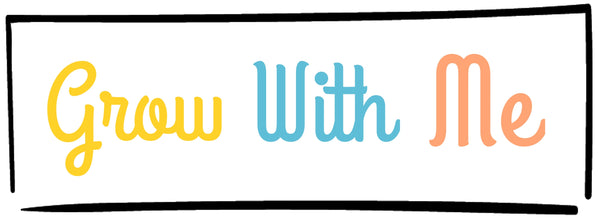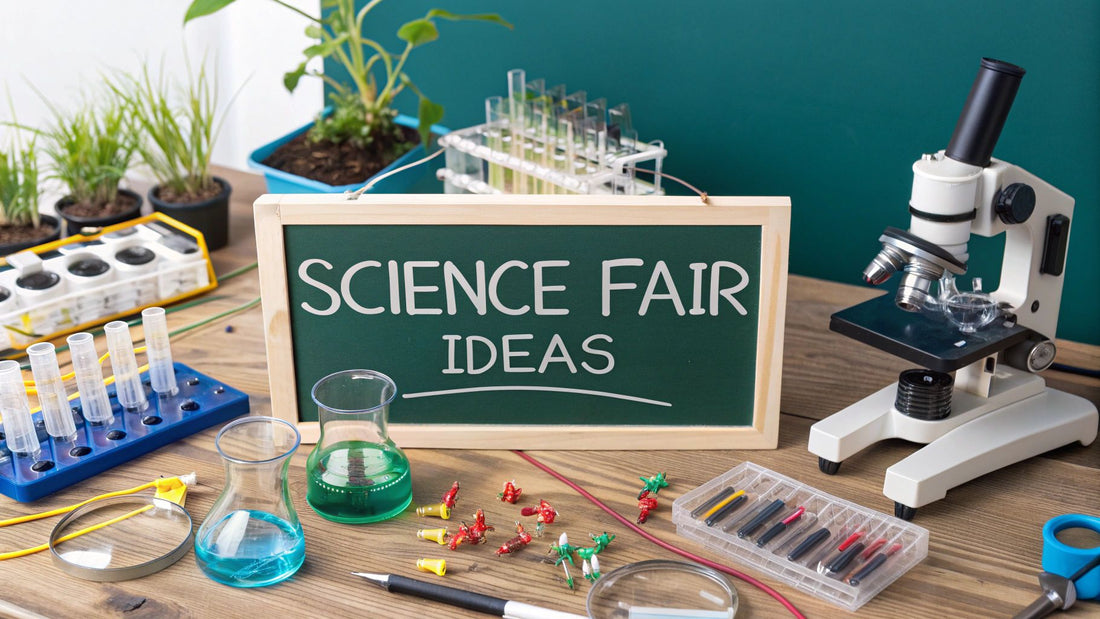
9 Top Science Fair Ideas to Spark Curiosity in 2025
Share
The annual science fair is a fantastic opportunity for young minds to explore the world, ask questions, and discover the thrill of investigation. Yet, coming up with a project that is both exciting and genuinely educational can feel like a significant challenge. Moving beyond the tried-and-tested classics is key to standing out and truly engaging with the scientific method, turning a school requirement into a genuine passion.
This guide provides a curated list of compelling science fair ideas, ranging from beginner-friendly experiments to advanced investigations that tackle real-world problems. We've structured each idea to not only guide you through the process but also to explain the 'why' behind the experiment, ensuring a deeper and more valuable learning experience. We will explore projects from volcano chemistry and plant growth to analysing microplastics and optimising solar panels.
Whether you're a parent guiding your child or a student seeking inspiration, these projects are designed to foster a real passion for science. Our aim is to encourage crucial skills in observation, data analysis, and creative problem-solving. Let's explore some innovative ways to make this year's science fair project an unforgettable journey of discovery.
1. Volcano Eruption Chemistry
This project is a classic for a reason; it provides a visually exciting and hands-on way to explore fundamental chemistry. The core concept involves demonstrating an acid-base reaction by mixing bicarbonate of soda (an alkali) with vinegar (an acid). This reaction releases carbon dioxide gas, which bubbles up and forces the "lava" out of a model volcano, simulating a real eruption.
This idea is perfect for younger students as it’s safe, easy to set up, and delivers an immediate, impressive result. It effectively introduces concepts like chemical reactions, gas production, and basic geological principles in an unforgettable way.
How to Implement This Idea
The key is to create a sturdy volcano structure, often using papier-mâché or modelling clay around a plastic bottle. The bottle acts as the magma chamber where the reaction will take place. For the eruption itself, you simply place a few tablespoons of bicarbonate of soda into the bottle, then pour in vinegar to trigger the fizzing "lava" flow.
Top Tip: For a more dramatic and realistic lava effect, add a few drops of red or orange food colouring and a squirt of washing-up liquid to the vinegar before pouring. The soap will help trap the carbon dioxide gas, creating more foam and a slower, oozier flow.
Project Variations and Enhancements
Beyond the basic model, you can elevate this project to explore more complex scientific questions. Consider these enhancements:
- Experiment with Ratios: Test how changing the ratio of vinegar to bicarbonate of soda affects the eruption's speed and duration.
- Model a Real Volcano: Research a specific volcano, like Mount Vesuvius or Mauna Loa, and design your model to replicate its shape and features.
- Create a Geological Cross-Section: Build your volcano with one side cut away to show the internal layers, including the magma chamber, conduit, and earth's crust.
This experiment is one of the best science fair ideas for demonstrating a clear hypothesis, procedure, and conclusion.
2. Plant Growth Under Different Light Conditions
This biology-focused project investigates how different colours and types of light impact photosynthesis and plant development. The core concept is to observe how variables like natural sunlight, fluorescent bulbs, or coloured LED lights affect a plant's growth rate, leaf size, and overall health. It's a fantastic way to visually demonstrate how plants rely on specific wavelengths of light for energy.
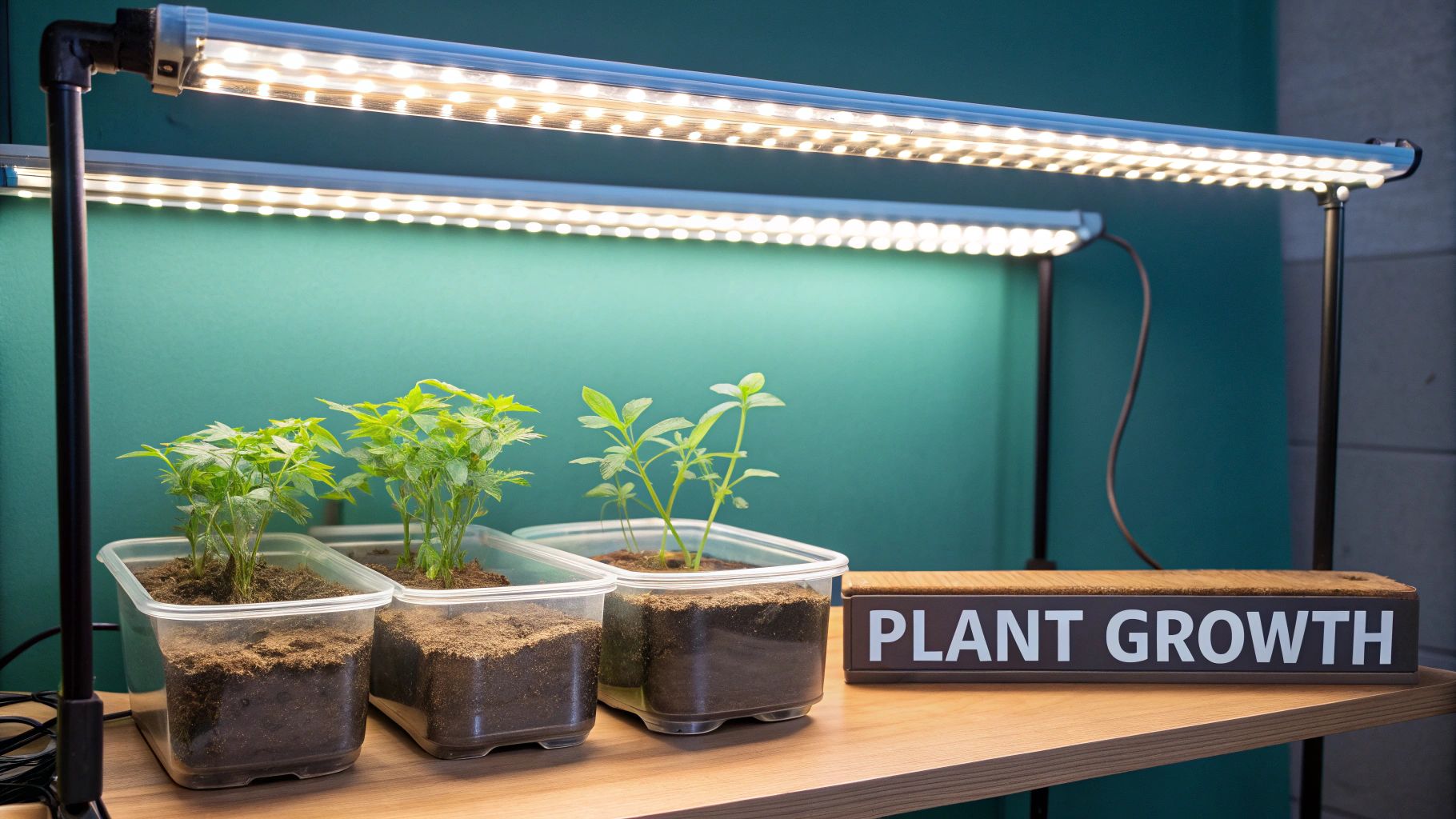
This idea is ideal for a wide range of age groups, allowing for simple observation or more complex data analysis. It masterfully connects key biological concepts like photosynthesis and the electromagnetic spectrum to real-world applications such as NASA's space agriculture research and modern indoor farming techniques.
How to Implement This Idea
The key to a successful experiment is controlling variables. Start with several identical young plants, such as beans or cress, in the same type of soil and pots. Place each plant under a different light source: one in natural sunlight, another under a standard LED bulb, and others under coloured lights (e.g., red or blue cellophane over a light source). Ensure each plant receives the same amount of water and is kept at a similar temperature.
Top Tip: Keep a detailed daily log for each plant. Measure its height with a ruler, count the number of leaves, and take photographs to create a clear visual record of its progress. This documentation is crucial for analysing your results and drawing a conclusion.
Project Variations and Enhancements
This foundational experiment can be expanded to explore more advanced scientific questions and become one of the most engaging science fair ideas. Consider these enhancements:
- Analyse Light Wavelengths: Research how specific wavelengths (like red and blue light) are most critical for photosynthesis and test this hypothesis directly using targeted LED grow lights.
- Explore Hydroponics: Grow the plants hydroponically (in water and nutrients, without soil) to see how light conditions affect growth in a different medium.
- Measure Biomass: At the end of the experiment, carefully remove the plants, dry them out, and weigh them to quantitatively compare how much biomass was produced under each light condition.
This project offers a brilliant opportunity to practise systematic observation, data collection, and analysis.
3. Water Quality Testing and Analysis
This project delves into environmental science by comparing water samples from various sources to assess their health and safety. The core concept involves collecting water from locations like a household tap, a local pond, a stream, and different brands of bottled water, then analysing them for key indicators like pH level, dissolved oxygen, nitrates, and bacterial presence.
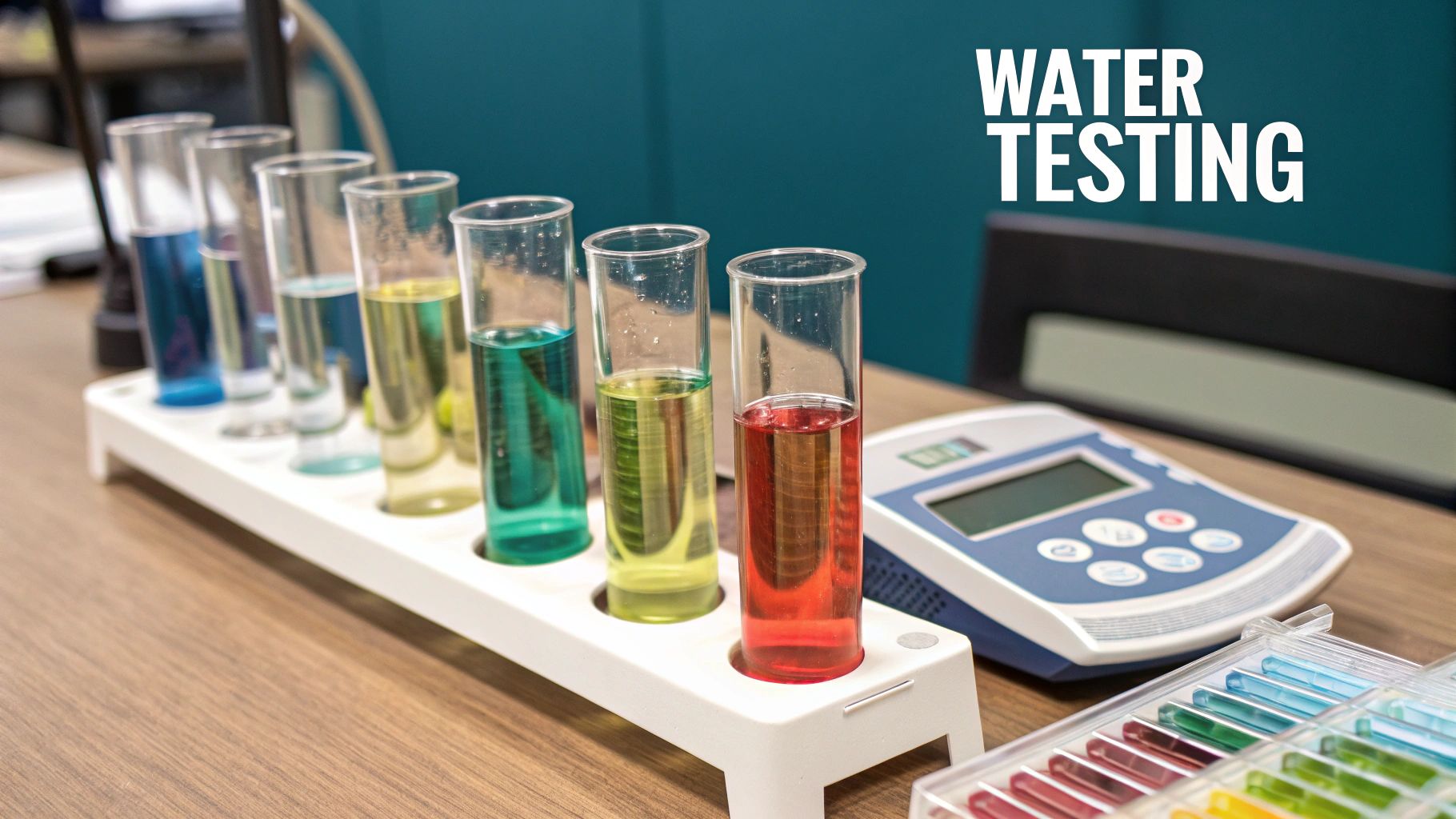
This idea is perfect for older students interested in chemistry, biology, and public health. It addresses real-world issues, mirroring the work done by organisations like the Environmental Protection Agency, and teaches precise scientific measurement and data analysis. It's one of the most relevant science fair ideas for highlighting environmental stewardship.
How to Implement This Idea
The foundation of this project is a reliable water testing kit, which can be purchased online or from a scientific supply shop. You must carefully collect samples in sterile containers, labelling each one precisely with its source, date, and time. Follow the test kit instructions for each parameter, meticulously recording the results in a logbook.
Top Tip: For the most accurate results, test each water sample multiple times and calculate an average. Document your collection points using GPS coordinates from a smartphone to add a layer of professional geographical data to your project board.
Project Variations and Enhancements
To take this project to a higher level, you can explore more complex environmental questions and presentation methods. Consider these enhancements:
- Impact of Pollution: Collect samples upstream and downstream from a potential pollution source, like a factory or farm, to analyse its impact.
- Filtration Effectiveness: Design and build your own simple water filters (using sand, charcoal, and gravel) and test their ability to improve the quality of a pond water sample.
- Aquatic Life Correlation: Study the types of insects and plant life found in the water sources and attempt to correlate their presence with your water quality findings.
This experiment provides a powerful opportunity to connect a school project with significant local and global environmental concerns.
4. Battery Power Comparison Study
This experiment delves into the practical science of electrochemistry and energy storage by comparing how different types of batteries perform. The core concept involves systematically testing various battery brands and types, such as alkaline, lithium, and rechargeable, to measure their longevity, power output, and overall value for money.
This project is excellent for older students as it teaches rigorous scientific testing, data collection, and analysis. It connects abstract concepts like voltage and current to tangible, everyday objects, making it one of the most relevant and practical science fair ideas.
How to Implement This Idea
The key to a successful comparison is consistency. You must use identical devices for each test, such as several of the same model of torch or motorised toy. Place a fresh battery from each category into a device, turn them all on simultaneously, and record how long each one lasts until the light dims or the motor stops.
Top Tip: Create a detailed logbook to record start and end times for each battery. To determine cost-effectiveness, divide the price of each battery by the number of hours it lasted. This will give you a "cost per hour" figure, providing a powerful data point for your conclusion.
Project Variations and Enhancements
To add complexity and depth, you can move beyond a simple longevity test. Consider these powerful enhancements for your project:
- Test Temperature Effects: Conduct the experiment in different temperature environments, like a cold garage or a warm room, to see how temperature affects battery performance.
- Analyse Environmental Impact: Research the materials used in each battery type and compare their environmental impact, from manufacturing to disposal and recycling options.
- Measure Voltage Drop: Use a multimeter to measure the voltage of each battery at regular intervals during the test. This allows you to plot a graph showing how its power output declines over time.
This study provides a fantastic opportunity to practise controlled experimentation and present clear, data-driven conclusions.
5. Microplastics in Water Sources
This project tackles a pressing environmental issue by investigating the presence of tiny plastic particles in various water sources. The core concept involves collecting water samples from different locations, such as taps, bottled water, rivers, or lakes, and using filtration and microscopy to identify and quantify microplastics. It offers a chance to engage with a real-world, current scientific challenge.
This idea is ideal for older students with an interest in environmental science and biology. It provides a powerful lesson in data collection, analysis, and the far-reaching impact of pollution, connecting a global problem to the local community and making it one of the most relevant science fair ideas.
How to Implement This Idea
The key is to establish a consistent sample collection and analysis method. Collect water in clean glass jars to avoid contamination. Use a series of fine-mesh filters or coffee filters to strain each sample, and then carefully examine the residue under a microscope. You will need to learn to distinguish plastic fragments from organic matter.
Top Tip: To make microplastics easier to see, you can use a dye called Nile Red, which causes many plastics to fluoresce under a blue or UV light. This advanced technique requires specific safety precautions but can dramatically improve the accuracy of your results.
Project Variations and Enhancements
This project can be adapted to explore a variety of hypotheses and deepen the investigation. Consider these enhancements:
- Compare Water Sources: Test and compare the concentration of microplastics in tap water, filtered water, bottled water, and a local river or stream.
- Analyse Different Plastic Types: Research methods to identify different types of plastic (e.g., fibres from clothing vs. fragments from packaging) found in your samples.
- Investigate Local Pollution Points: Take samples upstream and downstream from potential sources of pollution, like a water treatment plant or industrial area, to see if there is a noticeable difference.
This experiment is an excellent way for students to contribute to citizen science while learning advanced laboratory techniques.
6. Food Preservation Methods Effectiveness
This project delves into the fascinating world of food science, exploring how different techniques inhibit spoilage. The core concept is a systematic comparison of methods like refrigeration, freezing, dehydration, and salt curing to see which is most effective at preventing bacterial and mould growth on a specific food item, such as slices of apple or bread.
This idea is excellent for middle school and older students, as it blends microbiology, chemistry, and practical life skills. It clearly demonstrates the scientific principles behind why we refrigerate or freeze food, making abstract concepts tangible and relevant to everyday life. It’s one of the most practical science fair ideas available.
How to Implement This Idea
Select a single type of perishable food to test across all methods. Prepare several identical samples and include a control sample left at room temperature. Apply each preservation technique to its designated sample (e.g., place one in the freezer, pack another in salt, use a dehydrator on a third). You must then observe and document the changes in each sample over a set period, using photography to record mould growth and decay.
Top Tip: For a more advanced project, consider using agar plates to culture bacteria from each food sample at different time intervals. This allows you to quantify bacterial growth instead of relying solely on visual observation, providing more precise data.
Project Variations and Enhancements
This foundational experiment can be expanded to investigate more nuanced scientific questions. Consider these enhancements:
- Nutritional Content Analysis: Research how to test for the degradation of specific nutrients, like Vitamin C, in each preserved sample over time.
- Historical Methods Study: Replicate ancient food preservation techniques, such as smoking, pickling in vinegar, or preserving in honey, and compare their effectiveness to modern methods.
- Vacuum Sealing vs. Standard Freezing: Conduct a direct comparison to see if removing air through vacuum sealing significantly improves food preservation in a freezer.
This project offers a superb opportunity to practise sterile techniques, data collection, and long-term observation.
7. Solar Panel Efficiency Optimization
This project delves into the world of renewable energy engineering by testing how different factors affect a solar panel's energy output. The core concept is to measure the electricity generated by a small photovoltaic panel while systematically changing variables like its angle to the sun, surface cleanliness, and exposure to shade. It’s a brilliant way to explore physics, engineering, and environmental science.
This idea is ideal for middle or secondary school students interested in technology and sustainability. It provides tangible data and introduces key concepts like electrical circuits, solar irradiance, and optimisation, linking directly to real-world applications like residential solar installations and large-scale solar farms.
How to Implement This Idea
To begin, you will need a small, low-voltage solar panel and a multimeter to measure voltage and current. The experiment involves setting up the panel and taking baseline readings on a clear day. You then test one variable at a time, for example, by tilting the panel at different angles (e.g., 30, 45, and 90 degrees) and recording the power output at each position.
Top Tip: To explore the impact of cleanliness, you can apply a thin, even layer of dust or translucent material to the panel's surface and measure the drop in efficiency. This demonstrates why regular maintenance is crucial for real-world solar arrays.
Project Variations and Enhancements
This project offers numerous avenues for deeper investigation, making it one of the most versatile science fair ideas for older students. Consider these enhancements:
- Track the Sun: Build a simple mount that allows you to adjust the panel's angle throughout the day to track the sun’s path, comparing the energy generated against a fixed panel.
- Investigate Temperature Effects: Carefully measure how the panel's surface temperature (which can be increased using a safe heat source) affects its voltage output.
- Analyse Weather Data: Correlate your panel's output with local weather data, analysing how cloud cover, haze, and air quality impact its performance over several days.
This experiment provides a practical and data-driven approach to understanding the future of sustainable energy.
8. Air Quality Monitoring and Analysis
This project brings environmental science into the real world by investigating the air we breathe. The core concept is to measure and compare air pollution levels in different locations, helping students understand concepts like particulate matter, atmospheric chemistry, and the factors that influence environmental health. It's a highly relevant and impactful topic that connects scientific measurement with direct community impact.
This idea is perfect for older students who are ready to engage with data collection, analysis, and real-world problem-solving. It effectively introduces advanced concepts in environmental science, data interpretation, and public health, making it an excellent choice for a comprehensive and thought-provoking science fair project.
How to Implement This Idea
Begin by selecting different locations for monitoring, such as a busy road, a park, and an indoor space. You can use commercial air quality sensors or build your own simple monitoring devices. Collect data over a set period, recording levels of pollutants like particulate matter (PM2.5) and comparing your findings across the different environments.
Top Tip: Correlate your air quality data with weather conditions like wind speed, humidity, and temperature. This adds another layer of analysis, helping to explain why pollution levels might rise or fall on certain days.
Project Variations and Enhancements
Beyond basic monitoring, this project can be expanded to explore more complex environmental questions. Consider these enhancements:
- Indoor vs. Outdoor Air Quality: Conduct a focused study comparing the air inside a home or classroom to the air directly outside, investigating the impact of ventilation or indoor pollution sources.
- Historical Data Comparison: Use data from official sources like the EPA’s AirNow network to compare your current findings with historical trends in your area.
- Plant-Based Bio-Indicators: Research how certain plants, like lichens, can act as natural indicators of air quality and incorporate their observation into your study.
This is one of the most compelling science fair ideas for students interested in using scientific methods to address pressing environmental issues.
9. Crystal Growth Under Different Conditions
This project elegantly explores the fascinating world of crystallography, revealing how different environmental factors influence the formation and structure of crystals. The core idea is to grow crystals from common household materials like salt, sugar, or alum, and systematically alter variables such as temperature, solution concentration, or agitation to observe the impact on the final crystal size and shape.
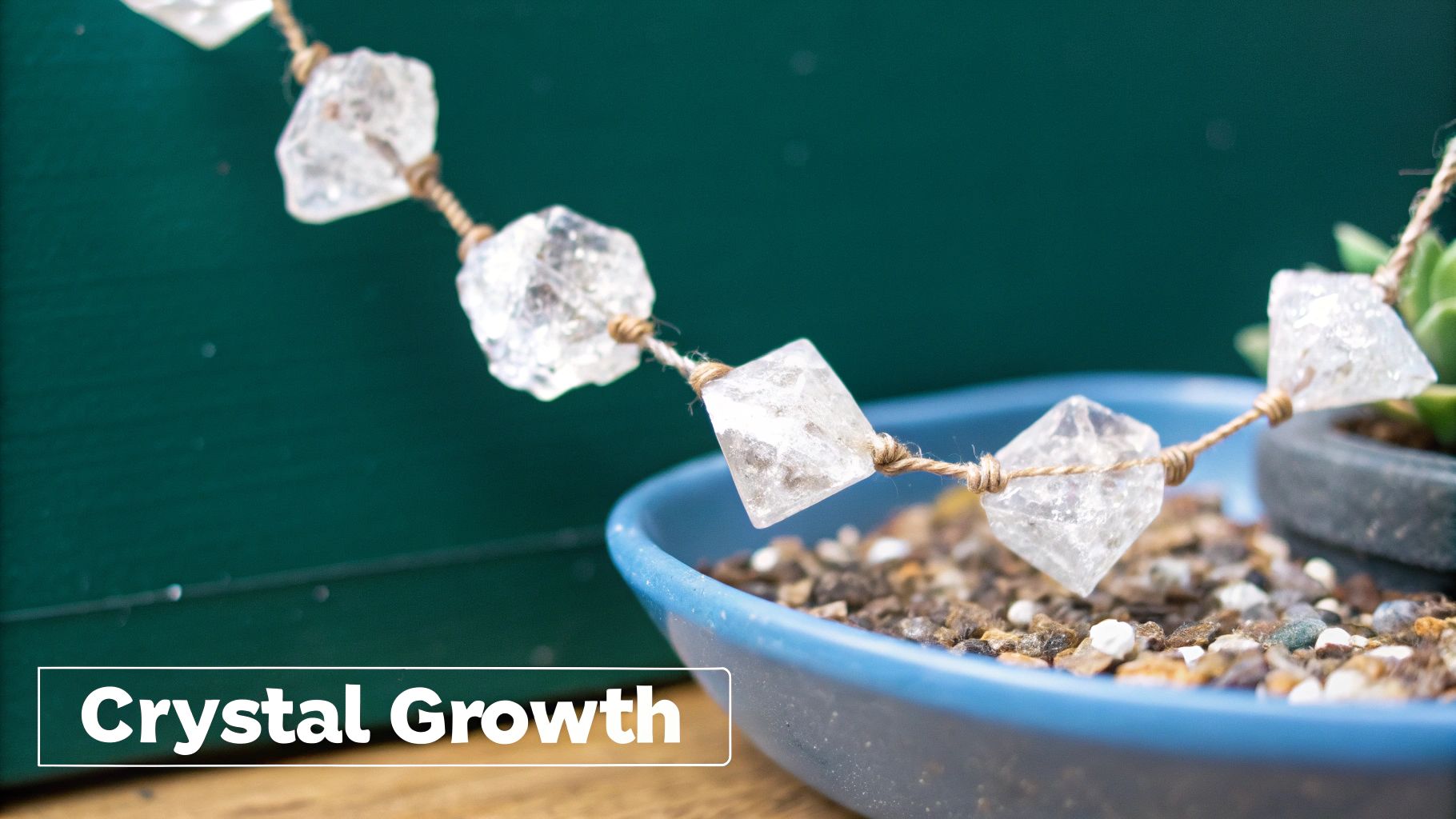
This idea is excellent for students interested in chemistry, geology, and materials science. It teaches patience, careful observation, and methodical experimentation, demonstrating how microscopic molecular structures form macroscopic, often beautiful, geometric patterns. It's a visually rewarding project that unfolds over several days.
How to Implement This Idea
The basic setup involves creating a saturated solution by dissolving as much of your chosen substance (e.g., Epsom salt, alum) as possible in hot water. This solution is then left to cool undisturbed in a clean jar. A string or pipe cleaner can be suspended in the liquid to provide a nucleation site, a surface where the crystals can begin to form.
Top Tip: For the best results, cover the jar with a coffee filter or paper towel instead of a solid lid. This allows the water to evaporate slowly, which encourages larger, more well-defined crystals to grow over time.
Project Variations and Enhancements
This is a fantastic base for more advanced science fair ideas. Students can expand their investigation by testing specific hypotheses:
- Temperature Control: Grow three sets of crystals: one at room temperature, one in a refrigerator, and one in a warm place. Compare the growth rate and final size.
- Investigate Impurities: Introduce small amounts of other substances, like food colouring or different types of salt, to a solution to see how they affect the crystal's colour and structure.
- Study Different Solvents: Try dissolving your chosen crystal-forming substance in different liquids (where safe and appropriate) to see if crystals form at all.
This project offers a clear and measurable way to explore scientific variables, from industrial salt production to gemstone formation.
Science Fair Project Ideas Comparison
| Project Title | Implementation Complexity 🔄 | Resource Requirements ⚡ | Expected Outcomes 📊 | Ideal Use Cases 💡 | Key Advantages ⭐ |
|---|---|---|---|---|---|
| Volcano Eruption Chemistry | Low (Beginner level, simple setup) | Low (common household materials) | Visual demonstration of acid-base reaction | Elementary to Middle School science fairs | Easy, safe, visually impressive |
| Plant Growth Under Different Light | Medium (requires long-term care) | Medium (plants, diverse light sources) | Quantifiable plant growth data | Biology/environmental science investigations | Teaches scientific method, real-world relevance |
| Water Quality Testing and Analysis | High (advanced tests, data analysis) | High (testing kits, lab equipment) | Comprehensive water quality data | Environmental monitoring and public health | Real-world impact, multiple parameters |
| Battery Power Comparison Study | Low to Medium (basic to intermediate) | Medium (batteries, devices) | Clear performance and cost-effectiveness results | Consumer tech evaluation, electrochemistry study | Practical, relatable, measurable |
| Microplastics in Water Sources | High (advanced lab skills required) | High (microscopy, specialized tools) | Identification and quantification of microplastics | Environmental research, community activism | High relevance, advanced techniques |
| Food Preservation Methods Effectiveness | Medium to High (sterile techniques) | Medium to High (lab equipment) | Bacterial growth and nutritional analysis | Microbiology, food science, cultural studies | Practical application, multiple variables |
| Solar Panel Efficiency Optimization | Medium to High (engineering focus) | Medium (solar panels, measuring tools) | Energy output optimization data | Renewable energy projects, engineering labs | Hands-on, current technology relevance |
| Air Quality Monitoring and Analysis | High (technical sensor use/data) | High (sensors, data tools) | Real-time air pollution data | Environmental health, community science | Critical health issue, tech integration |
| Crystal Growth Under Different Conditions | Low to Medium (controlled conditions) | Low to Medium (common chemicals) | Visual crystal formation and growth study | Chemistry, geology, materials science | Beautiful results, clear scientific concepts |
From Idea to Award-Winning Project: Your Next Steps
You now have a wealth of engaging science fair ideas, from the classic fizz of a chemical volcano to the critical analysis of microplastics in our local water. This list is designed to be a launchpad, a source of inspiration to ignite a passion for discovery. The journey from a promising concept to a polished, award-worthy project is where the real learning and excitement begin. Remember, the best projects aren't just about flashy results; they are built on a foundation of genuine curiosity and a well-organised scientific method.
Transforming Your Idea into a Hypothesis
The first crucial step is to narrow your chosen idea into a specific, testable question. For instance, instead of just "testing plant growth," a more focused hypothesis would be: "If a bean plant is exposed to 12 hours of blue light per day, it will grow taller than a bean plant exposed to 12 hours of red light per day over a four-week period." This creates a clear objective for your experiment.
The Blueprint for Success: Your Experimental Design
With a solid hypothesis, you can now outline your experiment. This plan is your blueprint and should include:
- Materials List: Be specific about everything you will need, from soil type to the wattage of your lightbulbs.
- Step-by-Step Procedure: Write down the exact steps you will follow, almost like a recipe. This ensures your experiment is repeatable and reliable.
- Identifying Variables: Clearly define your independent variable (the one you change, like light colour), dependent variable (the one you measure, like plant height), and controlled variables (everything you keep the same, like water amount and soil).
- Data Collection Plan: Decide how you will record your findings. Will it be a daily log, a chart, photographs, or a combination? Meticulous record-keeping is the hallmark of a great scientist.
A well-documented project tells a story. Your lab notebook or journal should capture every thought, measurement, and unexpected observation. This detailed record is often as impressive to judges as the final results themselves.
Ultimately, choosing one of these science fair ideas is the start of an incredible adventure in scientific inquiry. The process of asking a question, designing a test, and analysing the results builds invaluable skills like critical thinking, problem-solving, and resilience. Whether your experiment yields the expected outcome or a surprising twist, the experience gained is the true prize. Embrace the process, stay organised, and most importantly, have fun exploring the world around you. Your curiosity is the most powerful tool you have.
For our youngest scientists, cultivating that innate curiosity starts long before the science fair. Grow With Me offers stage-based play kits designed by Early Years experts to introduce foundational STEM concepts through hands-on, sensory play. Nurture your child's love for discovery from the very beginning by exploring our subscription boxes at Grow With Me.
